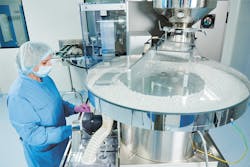Sealing challenges in the pharmaceutical industry
The pharmaceutical industry is very similar to many other process and production industries in terms of the plant and machinery used. Similarly, the processes employed to cultivate, refine and blend pharmaceutical ingredients and end products are widely used in other industries.
When looking at sealing applications and considering material suitability for the process conditions, the STAMPS process — size, temperature, application, media, pressure and speed — is a good starting point on the path to providing an appropriate sealing solution.
STAMPS factors for material selection are:
Size can sometimes be a limiting factor in terms of the method of manufacture and may exclude certain materials from the running.
Temperature is critically important in order to select the most appropriate material for the application. The temperatures during all parts of the duty cycle must be known including the minimum and maximum, along with typical running temperatures. It is also vitally important at this stage to consider any heat generated by friction on dynamic sealing applications.
Application details are an essential part of any sealing material selection. This would typically include information relating to the duty cycle, outlining relative movement of interfacing parts, heating times, running times, cooling times and any known variables such as the thermal expansion of components during the process.
Media that the sealing material comes into contact with is critical. A detailed definition of the media is required including details of the state (solid, powder, granules, flakes, slurry, liquid, gas) and any changes of state during the process. Also the chemical makeup is equally important so a breakdown by percent weight or volume of all key constituent parts aides with correct material selection.
Pressure in many pharmaceutical sealing applications is not critical for the material selection but is important for understanding the duty cycle as many applications switch between pressure and vacuum, which in turn impacts the dynamic forces acting on the seals.
Speed also has a major part to play in material selection as many sealing solutions involve a dynamic interface between the seal and a shaft, spindle or stator.
In addition to the application of STAMPS, other factors to consider include:
Material compliance
The terms "food-safe" or "pharma-safe" are often used when deciding on material suitability for pharmaceutical applications.
There are no universally adopted standards, such as from the International Organization of Standards (ISO), in place to define what food- or pharma-safe means. However, the most prominent quality standards on this front are regulated by the United States Food and Drug Administration (FDA).
The FDA is responsible for ensuring that any food or drug product available in the U.S. is safe, wholesome and sanitary.
CFR21.177.2600 describes the relevant regulations for "Rubber articles intended for repeated use," so is pertinent when selecting materials suitable for applications where a rubber seal comes into contact with food, pharmaceutical and nutraceutical products.
Within CFR 21.177.2600, the FDA lists materials that are considered safe for use in a food contact environment and so it follows that if a rubber seal is manufactured from 100 percent of a material or materials listed in CFR 21.177.2600, then it can be considered FDA-compliant.
This does not guarantee that the seal is safe for use in a food-contact application as the method of manufacture and the environment that the seal is manufactured in can affect the seal’s suitability for use in food contact processes.
It is vital to ensure that any seal is manufactured from FDA-compliant materials in a clean and controlled process environment to prevent contamination and ensure the end product is fit for human consumption.
kadmy/iStock
Material finish
The surface finish of any material used in a sealing solution that is used in a food or pharmaceutical production environment is also critical. In simplest terms, the surfaces of sealing components and their interfacing parts should be sufficiently smooth to prevent or restrict product adhesion. It is undesirable in any hygienic production environment to have "old product" build up on any surfaces as this can harbor bacteria that could contaminate current or subsequent batches of product.
Hygienic design
The European Hygienic Engineering Design Group (EHEDG) is a body that has been set up to develop best practices for equipment intended for use in hygienic industries. EHEDG offers practical papers and guidelines outlining ways to prevent issues such as bug traps, product buildup and cleaning dead-spots. When designing any sealing solution, following guidance notes published by EHEDG can help prevent the possibility of a contamination event, which could be very costly in terms of human impact, i.e., the consumer of the foodstuff or medication, and also commercial impact on the manufacturer in terms of potential product recalls.
Cleaning and validation
A major factor to consider for sealing applications in the food and pharmaceutical industries is the necessity for clean in place (CIP) and sterilize in place (SIP). CIP and SIP expose seals to a cleaning regime that can include cleaning fluids and chemicals, hot water, steam, localized jetting, spraying and flushing. Therefore, it is vital when gathering STAMPS details that information is gathered for the regular duty cycle and also any cleaning regime. This should also include any requirement for any disassembly, cleaning and reassembly where CIP and SIP cannot be facilitated, i.e., clean out of place (COP).
Ease of maintenance
The ability to quickly disassemble and reassemble can be greatly improved by using split-design seals that allow seals to be removed and replaced without having to carry out major engineering tasks such as decoupling a shaft and removing bearing and motor assemblies.
This is significantly important in the food and pharmaceutical industries as hygienic validation processes often require parts to be stripped down, removed and replaced, often resulting in several hours (or even days) of downtime if seal designs are not split.
Ingress and egress
In many industries, the main focus is on product leakage (egress), which again is critical to remain efficient and to lower any environmental or health and safety impact. When manufacturing food, pharmaceutical and nutraceutical products, preventing ingress of contaminants is paramount. To address this, dual-seal designs or seals with multiple stages of barrier, such as the use of a barrier fluid or purge, can address issues relating to ingress challenges.
Conclusion
When working in hygienic processing industries the sealing challenges are very different to those in other industrial sectors. While some seal designs from other sectors may have similar design features and operate using similar principles, it is a rare circumstance where a seal from another industrial sector can be directly transplanted into a hygienic application. Consideration should always be given to compliant materials, hygienic designs and cleaning regimes. From a maintenance perspective, major operational savings can be achieved by selecting designs that allow quick, easy and frequent maintenance and validation.




